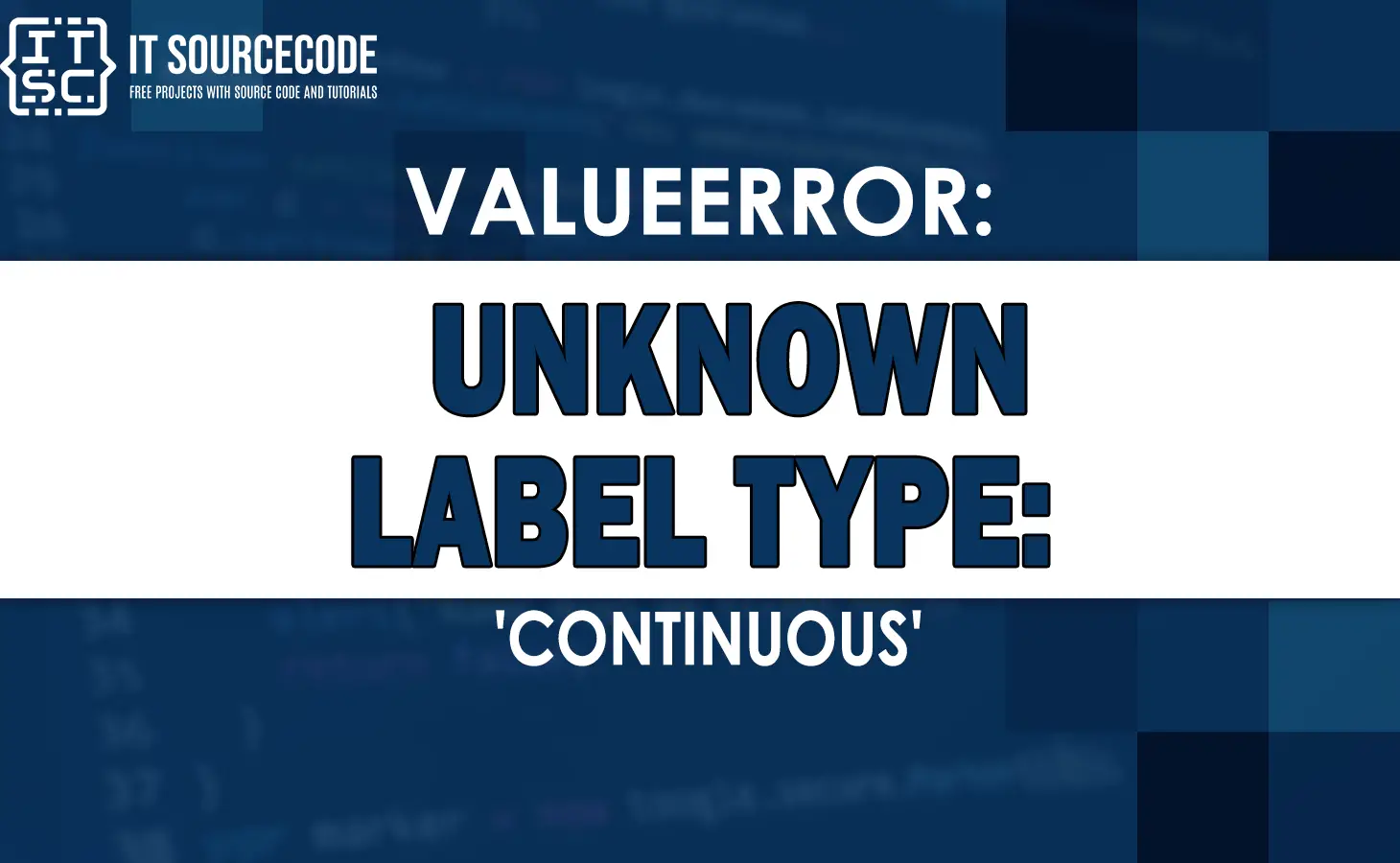In this article, we will learn the error valueerror: unknown label type: ‘continuous’ in Python programming.
Also, we will provide examples, solutions, and answers to frequently asked questions related to this error.
If you are encountering this issue, read on to find practical solutions and gain a better understanding of how to handle this error effectively.
Why Does this Valueerror: Unknown Label Type: Continuous Error Occur?
The “ValueError: Unknown label type: continuous” error typically occurs because we are trying to use a machine learning algorithm or function that expects discrete or categorical labels, but instead, you have provided continuous labels.
What is the Valueerror Unknown Label Type ‘Continuous’ Error?
The ValueError Unknown label type: ‘continuous’ error is encountered in Python when attempting to apply a classification algorithm or method to a target variable that is continuous type.
The error message demonstrates that the classifier cannot handle continuous labels since it expects discrete categorical labels.
Therefore, it is important to ensure that the target variable is properly categorized before using a classification algorithm.
Examples of the ValueError: Unknown label type ‘continuous’ Error
Here are the examples to understand more about the valueerror, let’s consider a few examples:
Let’s have a look at the example:
from sklearn.svm import SVC
from sklearn.datasets import make_regression
X, y = make_regression(n_samples=100, n_features=2, noise=0.1)
svm = SVC()
svm.fit(X, y)
In this example, we are using the Support Vector Classifier (SVC) from the scikit-learn library.
The make_regression function is generating a dataset with continuous labels (y).
When fitting the SVM classifier, we encounter the error:
ValueError: Unknown label type: ‘continuous’
Another example:
from sklearn.tree import DecisionTreeClassifier
from sklearn.datasets import make_regression
X, y = make_regression(n_samples=100, n_features=2, noise=0.1)
dt = DecisionTreeClassifier()
dt.fit(X, y)Here, we are using the Decision Tree Classifier from scikit-learn. Again, the make_regression function generates continuous labels (y).
When trying to fit the decision tree classifier, we encounter the same “ValueError” due to the continuous label type.
Traceback (most recent call last):
File “C:\Users\Dell\PycharmProjects\Python-Code-Example\main.py”, line 6, in
dt.fit(X, y)
File “C:\Users\Dell\PycharmProjects\Python-Code-Example\venv\lib\site-packages\sklearn\tree_classes.py”, line 889, in fit
super().fit(
File “C:\Users\Dell\PycharmProjects\Python-Code-Example\venv\lib\site-packages\sklearn\tree_classes.py”, line 224, in fit
check_classification_targets(y)
File “C:\Users\Dell\PycharmProjects\Python-Code-Example\venv\lib\site-packages\sklearn\utils\multiclass.py”, line 218, in check_classification_targets
raise ValueError(“Unknown label type: %r” % y_type)
ValueError: Unknown label type: ‘continuous’
What are the Common Causes of the Error?
The valueerror: unknown label type: ‘continuous error usually occurs due to the following reasons:
- Mismatched data types
- Incorrect dataset
- Missing preprocessing steps
Note: It is important to identify the cause of the error to determine the correct solution.
How to Fix the Valueerror: Unknown Label Type: Continuous?
To resolve the valueerror: unknown label type: continuous error, you can follow these solutions:
Solution 1: Check the target variable type
You can check the type of your target variable (y). Ensure that it is categorical (e.g., represented as strings or integers) and not continuous.
You can use the type() function in Python to determine the variable type.
For example:
# Assuming you have already defined your target variable 'y'
# Check the type of the target variable
target_type = type(y)
# Print the type of the target variable
print("Target variable type:", target_type)
In this code, the type() function is used to determine the type of the target variable y.
The resulting type is stored in the target_type variable, and finally, it is printed to the console using the print() function.
Solution 2: Perform label encoding
If your target variable is continuous, you need to convert it into categorical labels suitable for classification.
Label encoding can be used to assign unique integers to each category.
You can utilize the LabelEncoder class from the scikit-learn library to perform this encoding.
Example:
from sklearn.preprocessing import LabelEncoder
label_encoder = LabelEncoder()
y = label_encoder.fit_transform(y)
Solution 3: Apply one-hot encoding
If your target variable represents multiple categories, one-hot encoding can be used to transform it into binary features.
This encoding creates binary columns for each category, where a value of 1 indicates membership in a specific category, and 0 indicates non-membership.
Let’s take a look at the example:
from sklearn.preprocessing import OneHotEncoder
one_hot_encoder = OneHotEncoder()
y = one_hot_encoder.fit_transform(y.reshape(-1, 1))
Solution 4: Check the dataset
If the error persists, make sure that your dataset is correctly formatted.
You can that the target variable is separate from the features and properly labeled.
Also, confirm that the features contain of numeric or categorical values compatible with the chosen classification algorithm.
More Resources
Here are the following resources that will help you to understand more about VALUEERRORS:
- Valueerror: plot_confusion_matrix only supports classifiers
- Valueerror length of values does not match length of index
- valueerror: invalid mode: ‘ru’ while trying to load binding.gyp
- Valueerror: bad marshal data unknown type code
Conclusion
This valueerror unknown label type ‘continuous’ error usually occurs when we are attempting to train a classifier or perform classification tasks with labels that are not recognized or properly encoded.
By following the examples and solutions provided in this article, you can resolve this error effectively.
Remember to check the type of your target variable, perform appropriate encoding techniques, and choose suitable classification algorithms to handle continuous labels.
FAQs
You can use the type() function in Python to determine the type of your target variable. For example, type(y) will return the type of the variable y.
Yes, you can convert a continuous variable into a categorical one. Label encoding and one-hot encoding are common techniques used for this purpose.
Yes, there are algorithms specifically designed for regression tasks that can handle continuous labels effectively.
Some examples include linear regression, decision tree regression, and random forest regression.

